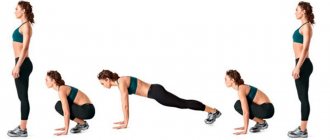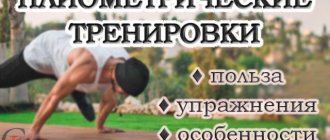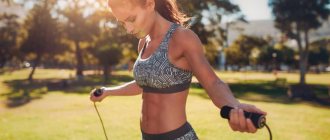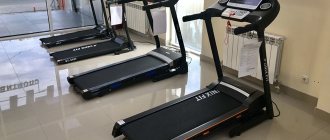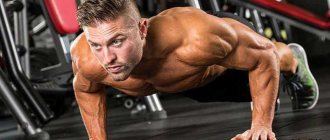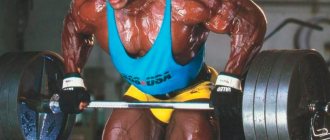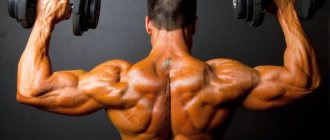Burpee (burpee) is the name of a special physical exercise that is a combination of push-ups and jumping jacks. Due to the speed, change of body position, increased breathing and pulse, the exercise perfectly accelerates the metabolism and is one of the best means of general physical training. Strengthens and slims the entire body.
The word burpee is a modification of the surname of the inventor of this exercise, which was originally an army physical fitness test. His name was Royal Huddleston Burpee.
Burpees in their modern form are alternating regular push-ups and jumping jacks. They did push-ups, then quickly stood up and jumped in place. Then they again fell into a prone position, did push-ups, jumped up... But this was not always the case (see below).
Burpee technique
Quickly bend your elbows. Touch your chest to the floor. Extend your elbows. It turned out to be one full push-up.
Next, jump and pull your knees toward your chest. Take a squat position with your hands on the floor. Push your feet off the floor and jump as high as you can. Raise your hands up.
Once you land, quickly lower yourself into a deep squat with your hands on the floor. Next, jump into a lying position. One repetition of the exercise is thus completed.
Then simply repeat the same number of times. Burpees are usually performed 10-20 or more per set. If the exercise is performed by a trained person, the number of repetitions can easily be 50 or even 100 without stopping.
https://www.youtube.com/watch?v=2FfO4WFOJFo
Please note that as the exercise progresses, it becomes increasingly difficult and the speed drops noticeably. This is completely normal. The last repetitions often look like a slow motion movie :)
What is a jumping jack and why is it needed?
“Jumping Jack” (Jumping Jack or Jumping Jack) is a favorite exercise of all famous fitness bloggers, athletes and simply active and positive people. The description sounds simple: these are fairly intense jumps with arms and legs spread out to the sides.
This activity is both a warm-up and a powerful cardio fitness workout.
Exercise options for beginners and women
Not only well-trained athletes can benefit from burpees, for whom it is not a problem to perform 50-70 or more push-ups at a time. Many people cannot do a single push-up for various reasons. Burpees are especially difficult for people who are overweight and lack physical fitness. Therefore, if your trainer has prescribed burpees, you can use the lighter options described below.
Lightweight burpee options
- Lie down and stand, like in the army. Just lie on your stomach. Then, in any available way, you need to get into a standing position. You can first get on all fours and then get up. The main thing is to try to do this as quickly as possible so that there is a good training effect.
- Push-ups can be done from your knees (see push-ups from your knees). This makes the overall movement a little more difficult, but makes burpees easier if push-ups aren't your forte.
- Push-ups can be done not deep, only part of the amplitude. And you can’t jump out very fast and not very high.
- You don’t have to do any jumping, just rise to a standing position after doing push-ups.
- There are other options that come down to a combination of the previous points.
https://www.youtube.com/watch?v=JKqA1Ayvkso
How to distinguish heart disease from others
Many people experience chest pain not necessarily due to any heart disease. Often this occurs due to another illness. If your heart hurts, it can be caused by diseases of the musculoskeletal system, respiratory, digestive and other diseases. However, only a doctor can make an accurate diagnosis after examining the patient.
But any person who has experienced such signs should understand if the heart hurts, what to do and how to recognize that it really is a heart disease. You need to know this in order to promptly consult a specialist in case of some serious pathologies. The signs of the disease may vary; you must learn to recognize them. The most important thing is to distinguish between cardiac and non-cardiac pain. For this purpose, you need to know the duration and intensity of the attack. In addition, it is advisable to have information about other diseases whose symptoms are similar to those of the heart.
The first symptoms of a heart attack
Discomfort in the chest can occur for various reasons. To understand that the heart hurts, it is advisable to know several characteristic symptoms. Seizures are not always accompanied by unpleasant sensations. At the same time, people with other ailments complain that they have difficulty breathing and pain in the left side of their chest. But all this is not a consequence of cardiac diseases.
The earliest signs that indicate that the functioning of the human body’s motor system is impaired most often appear several months, or even years, before the first attack. Therefore, everyone should know how and where the heart hurts. Early signs of the disease that should alert you are:
- Painful sensations behind the ribs. They hit the back, arm, neck, teeth. The left side is most often affected. At the same time, there is shortness of breath, nausea, and increased sweating.
- Discomfort after physical activity, stress, which disappears after rest or nitroglycerin tablets.
- Shortness of breath appears even with moderate exertion, simple work, while eating, and even in a lying position. Before the attack begins, the patient may sleep while sitting or suffer from insomnia.
- Severe fatigue from usual activities can begin long before the first attack.
- Representatives of the stronger sex sometimes develop erectile dysfunction several years before the diagnosis of coronary artery disease.
- Swelling. This symptom is considered the most basic evidence of cardiac dysfunction. At first, the swelling is almost invisible, but becomes larger over time. This is noticeable when a person removes shoes or rings from their fingers. If swelling is observed, you should consult a specialist and undergo an examination.
- Stopping breathing during night sleep, as well as snoring. These signs indicate a predisposition to an attack of heart disease.
Signs of coronary diseases
1. Myocardial infarction
Heart attacks can occur in different ways and how the heart hurts , symptoms in women and men in different situations can be different. In the case of myocardial infarction, everything happens approximately like this:
- There is a feeling of heaviness, pain in the central part of the chest, arm.
- Discomfort spreads to the left arm, neck, throat, and lower jaw.
- You feel dizzy, sweating, your skin becomes paler, and you feel nauseous.
- There is a feeling of heaviness in the stomach, a burning sensation in the chest.
- Anxiety, weakness.
- Rapid pulse.
The course of a heart attack may be different. Sometimes there are no signs at all. Sometimes the patient says that he experiences discomfort in the chest, sometimes there are no such symptoms and the process can be painless. Signs of a major heart attack: shortness of breath, blue lips, etc. very similar to symptoms of acute heart failure.
The duration of such an attack is approximately thirty minutes. Nitroglycerin doesn't help at all.
2. Ischemia
The main manifestation of IHD is angina attacks. In this case, pain occurs in the heart; the symptoms are the same in women and men. Among them:
- cardiopalmus;
- dyspnea;
- cardiac dysfunction;
- inconsistent pulse;
- dizzy, nauseous;
- weakness, sweating.
With coronary artery disease, patients report that they have a burning sensation and pressure in their chest. There is a feeling of being overwhelmed. Often unpleasant sensations are transmitted to the arm, neck, and throat. Most often observed during physical activity, stress and stop when the person remains alone.
With angina at rest, pain in the heart, the causes of which are different, appears at any time, even at night. This form is considered unfavorable.
Inflammatory heart diseases
1. Pericarditis
Pericarditis is an inflammation of the outer lining of the heart, the main symptom of which is a dull pain in the heart area. The pain is usually in the center of the chest, in some cases it radiates to the arm, back, and neck. When swallowing, coughing, etc. discomfort intensifies. Lying down makes it worse, sitting up makes it better. Although the nature of the soreness is usually dull and aching, in some cases it can be acute. Pericarditis is also characterized by rapid heartbeat.
2. Myocarditis
Inflammation of the myocardium is one of the reasons why the heart hurts; approximately 90 percent of people complain about it. Its form can be different, it appears regardless of physical activity, but after some time it can become stronger. Nitroglycerin doesn't help.
Heart valve diseases
If valve disease is present, its severity cannot be judged by symptoms. The patient may not complain about anything and still be in serious condition. Main symptoms:
- Shortness of breath, which is observed not only during high loads, but even during the most usual activities and in a supine position;
- Discomfort in the chest during exercise, breathing in cold air;
- Weakness, dizziness;
- Heart rhythm disturbance. These are, in particular, an uneven pulse, rapid heartbeat, and disturbances in the functioning of the heart.
This pathology often leads to heart failure. Then the following symptoms appear: the legs swell, the stomach bloats, and body weight increases.
Cardiomyopathy
Almost all people who have this pathology complain of pain. As the disease progresses, the way the heart hurts and the symptoms change. At first, the pain is long-lasting, does not depend on physical activity, and nitroglycerin does not help. Feels in different places. Then it is spontaneous or paroxysmal in nature after exercise and most often goes away after taking a nitroglycerin tablet. Its character can be different, its localization is precise, but sometimes it spreads over a large area. Nitroglycerin does not always help.
Arrhythmia
There are several types of arrhythmias. They are characterized by changes in heart rhythm. There are several types of ailments that cause heart pain radiating to the left arm.
Heart defects
These diseases can be acquired or inherited. For a long time they may not talk about themselves. Sometimes your heart hurts; your doctor should tell you what to do. This pain is usually aching, cutting or stabbing in nature. Accompanied by high blood pressure.
Mitral valve prolapse
Aching or pressing pain that appears on the left side is not caused by physical activity. They do not stop after taking nitroglycerin. In addition, dizziness, rapid heartbeat, and headaches may occur in the morning and evening. Possible shortness of breath, lightheadedness.
Aortic stenosis
With this disease, there is a pressing sensation in the chest. There is a strong heartbeat, weakness, fatigue, shortness of breath during physical activity. Over time, shortness of breath and dizziness occur during night sleep. If you suddenly change your body position, you may faint. Attacks of asthma and angina pectoris are possible.
Thromboembolism of the pulmonary artery
This is a very serious condition that requires immediate attention. The first sign of the disease is a stabbing pain in the heart area, which becomes stronger when inhaling and does not radiate to other places. The patient's skin turns blue, blood pressure decreases, shortness of breath and rapid heartbeat appear. Nitroglycerin has no effect.
Aortic pathologies
Sudden, very strong painful bursting sensations in the chest are a consequence of aortic dissection. They are sometimes so painful that a person can lose consciousness. The patient needs emergency medical care.
If there is an aortic aneurysm, there is aching or throbbing pain in the heart, a specialist must decide what to do. If an aneurysm ruptures, the pain becomes unbearable. If measures are not taken, death may occur.
Non-cardiac diseases
1). Intercostal neuralgia. Many people who feel such pain in the heart area mistake it for heart pain. However, in reality they are different. With neuralgia, the pain is sharp and stabbing in nature. They intensify when coughing, deep breathing, sudden turns of the body, etc. This can go away quite quickly, sometimes the pain lasts for several hours. The patient can accurately determine the location of the discomfort; it is located between the right ribs. In the case of angina pectoris, a person experiences a burning, aching feeling that does not go away when the position of the body changes. It is impossible to determine the exact location.
2). Osteochondrosis. This disease is quite easy to mistake for angina pectoris. The person is sure that his heart hurts, the symptoms are as follows: numbness occurs in the left hand, and it becomes more painful when moving. All this is especially similar to angina pectoris when an attack occurs during night sleep. The main difference is that nitroglycerin does not work.
3). Diseases of the central nervous system. In such a situation, patients often complain. However, symptoms vary. This can be regular, short-term, acute or aching pain in the heart area. Neuroses, as a rule, are characterized by a variety of vegetative disorders. A person may experience anxiety, insomnia or, on the contrary, increased sleepiness. Your hands get cold or cold, your head starts to hurt, and much more. Often patients suffering from neuroses complain, talking about numerous symptoms that they do not actually experience. And the “core people” are very reserved in sharing their feelings. Sometimes it is difficult to understand whether a patient has ischemic heart disease or cardioneurosis, since the cardiogram does not show any changes.
4). Disturbances in the functioning of the gastrointestinal tract. However, in this case, heart pain symptoms are somewhat different. They last longer, and the person feels nauseous, vomits, and develops heartburn. The intensity is determined by food intake. Often the symptoms of acute pancreatitis are similar to myocardial infarction. Sometimes exacerbations of gallbladder diseases radiate to the left half of the chest and it seems that the pain is in the heart. To understand what the problem is, you should take antispasmodics. If relief occurs, then the patient has gastrointestinal diseases.
5). Pulmonary diseases. Painful sensations similar to heart pain sometimes appear with pneumonia. This can also happen with pleurisy. But in this case, the pain is acute, intensifying with inhalation and coughing.
What to do?
Every person who feels pain in the chest thinks about what to do next. If there is any suggestion that your heart is hurting, you need to take immediate action. After all, the cause may be serious, in particular myocardial infarction or an attack of angina. Therefore you need to do the following:
- You should calm down and sit down. A stressful state will only worsen the situation.
- You need to try to take a different position. If after this there is relief, there is a possibility that the reason is different. If the pain increases, a pressing pain appears in the heart area, there is a risk that it is angina pectoris.
- It is recommended to allow access to fresh air and open a window.
- To prevent breathing from being constricted, you need to make your clothes looser, unbutton your collar
- If you suspect angina, take a nitroglycerin tablet and place it under your tongue. If relief does not come within a quarter of an hour, you need to take another tablet. You should call for emergency assistance. The medicine does not work for a heart attack.
Finally
Even if the pain in the heart area, the cause of which must be determined by a specialist, has gone away, you need to go to the hospital as soon as possible and get examined. Self-medication is unacceptable.
In Nizhny Novgorod, you can undergo a preventive examination at the Road Clinical Hospital, where professionals work.
Why do burpees help you lose weight?
Because this is not only a load on all the large muscles of the body, but also a repeated change in body position from horizontal to vertical. Burpees for weight loss work exactly like this.
The physiological reaction to such a change in position is the production of the hormone adrenaline. And this is one of the important fat-burning hormones that accelerate metabolism.
By the way, it is for this reason that it is not advisable to do burpees in the evening. The effect of the exercise can be like a couple of cups of strong coffee!
What muscles are used in the Jack plank?
Plank jumps require both muscles to maintain isometric hold on the plank and muscles to create movement in the hips and legs. First, they work the internal and external obliques, rectus abdominis, transverse abdominis, and other core muscles to keep your body straight.
To keep the body stable, the muscles of the posterior chain are activated: hamstrings, glutes, spinal erectors, rhomboids, rear deltoids and lats. Because you're elevated off the floor, jacks activate your forearms, biceps, triceps, anterior deltoids, and pecs to help you maintain a stable plank position. The dynamic part of the exercise works the abductors (pull body parts outward from the midline of the body) and adductors (adductors that return body parts to the midline). Meanwhile, the calf and foot muscles contribute to explosive jumping.
This list of active muscles is what makes the Jack Plank an exercise for the whole body, not just the core muscles.
Warm-up
- Initial muscle warm-up. Includes jumping rope, regular squats, jumping jacks, jogging in place and other exercises for beginners. Warm-up is designed to activate the circulatory system.
- Working out the ankles. Raise your leg in front of you, begin to pull your foot up towards your body, and then lower it down towards the floor. Do about 12 repetitions, change legs. You can use a support.
- Warm up your wrists. Extend your arm forward, straighten your elbow, turn your palm up. Start pressing on the palm of your other hand so that it becomes closer to the wrist. Repeat for the other hand.
- "Cat". A classic yoga pose that is perfect for preparing for a bridge. Starting position - on all fours, back straight, wrists under shoulders. As you inhale, lower your stomach down, arching your back; as you exhale, arch your back and pull in your stomach.
- Continuation of yoga. Other poses aimed at developing the back, shoulders, arms, and legs are also suitable from this direction.
Advice! For convenience, it is recommended to use a mat or soft covering that will not slip and prevent discomfort. Many beginners give up just because their palms and feet begin to hurt.
Who is not recommended to exercise jumping jack?
Like any other activity, this one has its contraindications. And if they are not taken into account, then the benefit can easily turn into harm:
- rehabilitation after operations and serious illnesses;
- pregnancy at any stage;
- 2-month period after childbirth;
- previous injuries to the spine, legs, shoulders;
- serious problems of the musculoskeletal system;
- knee problems;
- significant obesity;
- varicose veins;
- diseases of the heart and blood vessels, thrombophlebitis.
If you, dear readers, have doubts about any of your health problems, and are not sure that you can do jumping jack, be sure to consult your doctor.
He, and no one else, will tell you for sure whether this activity is allowed in your case.
Standards for standing jump
The first serious encounter with jumping occurs at school during physical education lessons. First, the teacher teaches the technique of standing long jump, and at the end of the year you need to pass the standards.
Every year they become stricter and stricter, taking into account the age of the growing child. Examples of standards can be seen in the table below.
The student makes three attempts and the best result is graded.
An attempt is not counted if the athlete violates one of the rules:
- You must not step beyond the take-off line or touch it.
- You cannot push off with your legs one by one - only with both legs together.
- You cannot use additional weights thrown forward during a jump.
- You cannot pre-jump before pushing off from the ground.
If we are talking about adult athletes, then the standards for them differ depending on age. Look at the data in the table, where B is bronze, C is silver, Z is gold.
Compliance rules and violations are no different from school standards.
